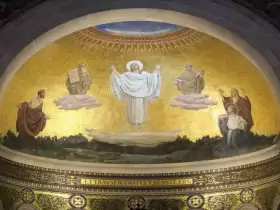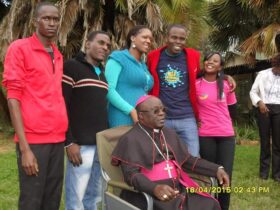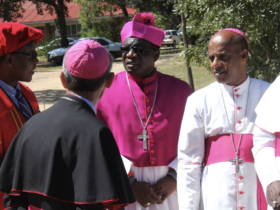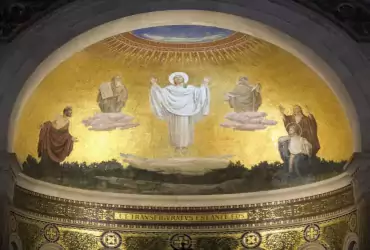Jesuit Brother Bvukumbgwe, who died in 2002, was a composer whose songs
are widely used in Church liturgies in Zimbabwe. One who knew him wrote:
Many of his songs come to him in his dreams at night. He would rise from his bed,
sing or hum them into a cassette and go back to sleep. In the morning he played the
cassette to his singers who then produce the song. While driving me to his village, he
would be lost in his musical thoughts and his fingers and hands on the steering wheel
would sometimes keep time with his thoughts. … The rhythm … improvises on the
theme carrying it to new depths of meaning and experience.
Bvukumbgwe experienced the music first in his mind and then shared it with
others and it finally became a song captured on a cassette. Mary, also, first
experienced something beyond words and immediately went ‘in haste’ to share
it with Elizabeth and finally the news became something written down and
shared with the world.
But it was not quite so simple. They fought over how to put it into words for
centuries until finally, in 431, they agreed, in a place that is now a ruined city in
western Turkey (Ephesus), that she could be called Theotokos, God bearer, that
is, Mother of God.
First comes the experience. Then the putting it into words. People were drawn
to Mary, over the centuries, as a way to God, a mother who longed to bring her
children to know their need for her Son. The Franciscans, in the fourteenth
century, grounded her in human experience by setting up Christmas cribs where
children and grown-up children came and contemplated in wonder.
Some five hundred years later (in 1854), the Church tried again to put into
words the experience of how Mary must have begun her existence by describing
her as ‘Immaculately Conceived’. Many good Christians baulked at this and
accused the Catholic Church of inventing something that wasn’t in scripture.
But the Church was only trying to express her experience of Mary. Given who
she was and what she became, it is not beyond our imagination that, by a special
gift of God, she could have experienced the perfection we all long for from the
moment she began to live.
And a hundred years later (in 1950) there was yet another attempt to put into
words something that the Church, especially the Eastern Church, had
experienced from the earliest centuries: that, at the moment of her death, Mary
achieved the completion we all instinctively long for. It was expressed in terms
of her being ‘assumed’ – bodily – into heaven. Anyone who believes the earliest
creeds of the Church, holds ‘the resurrection of the body and life everlasting.’
But the Church, drawing again on experience, declared that in the unique case
of Mary, her ‘Assumption’ was immediate. She shared in the first fruits (1 Cor
15:23). Even if we knew where she died, which we don’t, we would never find
any of her remains.
An Italian artist, Francesco Botticini, painted The Assumption of the Virgin in 1475
Prominent in the foreground is an empty tomb, reminiscent of the empty
tomb of Jesus in the gospels. There is no body and the earthly onlookers are
puzzled. Botticini then has our eyes rise to a scene above, representing heaven,
where Mary is in glory kneeling before her Son with the whole court of heaven
in attendance.
The importance of Mary, especially in the Catholic and Orthodox Churches, is
that she became the first person to receive the completion of life which was
promised by God to all of us from the beginning. This, again, sounds like a lot
of words but it is really the experience of love received and given in its fullness.
We celebrate the feast of the Assumption this Sunday, 20 August. I am grateful
to Fr James Hanvey SJ, for his thoughts on this great event in ‘Thinking Faith’.
Rev 11:19, 12:1-10 1 Cor 15:20-27 Luke 1:39-56
By Fr David Harold-Barry SJ










Leave a Reply